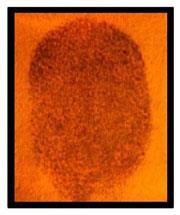Self assembled gel senses TNT at the attogram level, suggesting a cheap and easy method of TNT detection
Indian scientists have created a gel that gives a fluorescence response when exposed to particles of explosive trinitrotoluene - better known as TNT. By adding the gel to filter paper, they have shown how to make a cheap system for quick and easy TNT detection that is nonetheless highly sensitive.

The explosive is still widely used in devices such as landmines, and it contaminates water and soil, leaving behind a long legacy.
Sniffer dogs and ion mobility spectroscopy are the most widely used TNT detection methods, but both can only be used in certain circumstances and the latter requires quite a bit of kit. Chemical ’noses’ have been developed, including ones that use fluorescent techniques. But these are technologically sophisticated - fine for the US military, say, but less good for use in poorer areas or by untrained personnel.
Therefore, Ayyappanpillai Ajayaghosh and his team at the National Institute for Interdisciplinary Science and Technology in Trivandrum decided to investigate whether fluorescent gels could be used to detect TNT. They used OPVPF, a perfluoroarene based gelator known to form arene-perfluoroarene interactions in a brick wall arrangement. The team suspected that such an organisation might result in fluorescence quenching by the electron deficient aromatic TNT molecules.
A solution of OPVPF gave only a weak response to TNT and so the team made a gel using a solution of OPVPF, which fluoresced yellow. In addition, the researchers coated the gel on filter paper, changing the emission to an orange-red colour. Both the gel and the coated paper, however, showed a fast quenching of the fluorescence when exposed to TNT (within five seconds of exposure).
Different nitro-aromatics do also give a quenching effect, but this shouldn’t be a problem say the researchers because such compounds are often bi-products of TNT manufacture and present with TNT.
’This work is an excellent demonstration of the idea that new and useful properties can emerge from a self-assembled material that are unavailable from the individual components,’ says Anne McNeil who works on stimuli responsive gels at the University of Michigan, US. ’The "test strip" concept, wherein a piece of filter paper was coated with the gel aggregates and dried, was brilliant because it enabled surprisingly low detection limits while retaining fast detection speed due to facile vapour diffusion’.
The test strip can be used to detect concentrations of TNT at the attogram level, and can work with solid residue, vapour or solutions of TNT, and so could be used for environmental monitoring as well as security applications.
Laura Howes
References
KK Kartha et alJ. Am. Chem. Soc., 2012, DOI: 10.1021/ja210728c






No comments yet